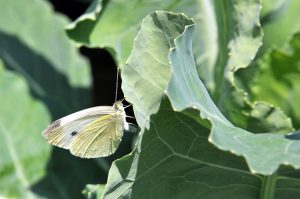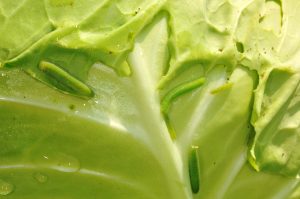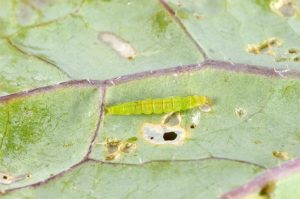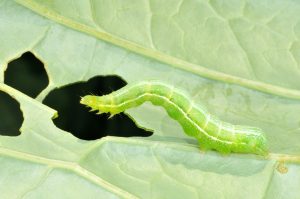Crucifers such as cabbage, cauliflower, and broccoli are frequently attacked by a variety of caterpillars, with the most important being the imported cabbageworm, diamondback moth, and cabbage looper.
The first caterpillar pest to attack crucifers is the imported cabbageworm. The adult stage is the common white butterfly that you will see flying around your field (Figure 1.). They lay eggs singly on the leaves. The larvae are velvety green and move very slowly (Figure 2.). They will consume large amounts of plant tissue and will also contaminate the heads with their feces. Your first indication of activity is when you see the daytime flying butterflies in your field. Once the butterflies are observed, you should begin watching your plants for signs of damage. Plants can tolerate a considerable amount of feeding damage on the leaves before heads begin to form. See the table on page 101 of the Midwest Vegetable Production Guide for details about thresholds. These insects are easy to control, as evidenced by the number of products recommended. It should be noted that some of the Bt products, will control this pest as well as many of the more conventional products.
The diamondback moth is the next caterpillar to arrive (Figure 3). The adults are small moths with a diamond shape on their backs. The larvae are much smaller than the other two species and do less damage per caterpillar, but can occur in much higher numbers. When disturbed, the larvae may drop to the ground on a silken thread, or wiggle like a fish out of water. Diamondback moths are one of the species with a great ability to develop resistance to pesticides. As a result, you may need to experiment a little to see which products work. The pyrethroids are cheap and effective if resistance is not an issue, so those products should be tried first. If they are not effective, again there is a wide variety of options available, as listed in the Midwest Vegetable Production Guide.
Cabbage loopers are usually the last pest to arrive because they do not overwinter in Indiana and must fly in from southern locations. The adults are kind of nondescript moths that lay eggs at night. The larvae are easy to identify because of the looping motion they make when crawling (Figure 4). These larvae, like imported cabbageworms, can do a large amount of damage per caterpillar. Cabbage loopers are often the hardest of the three species to control. The Bt insecticides tend to be less effective on loopers. Resistance is not an issue so the pyrethroid insecticides, along with a host of others, will provide good control.



